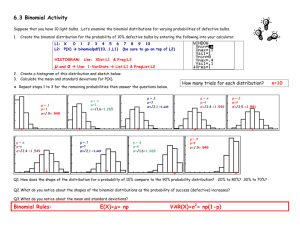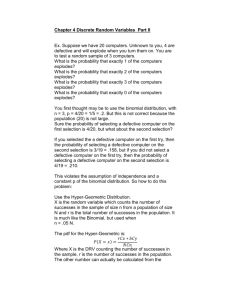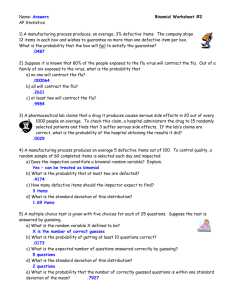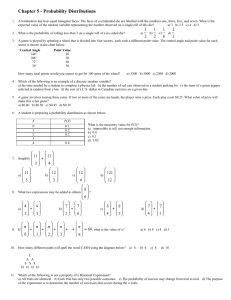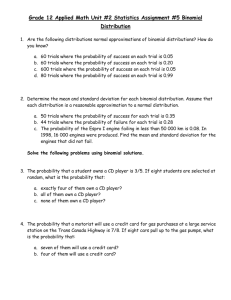Chapter 3 notes (WORD)
advertisement
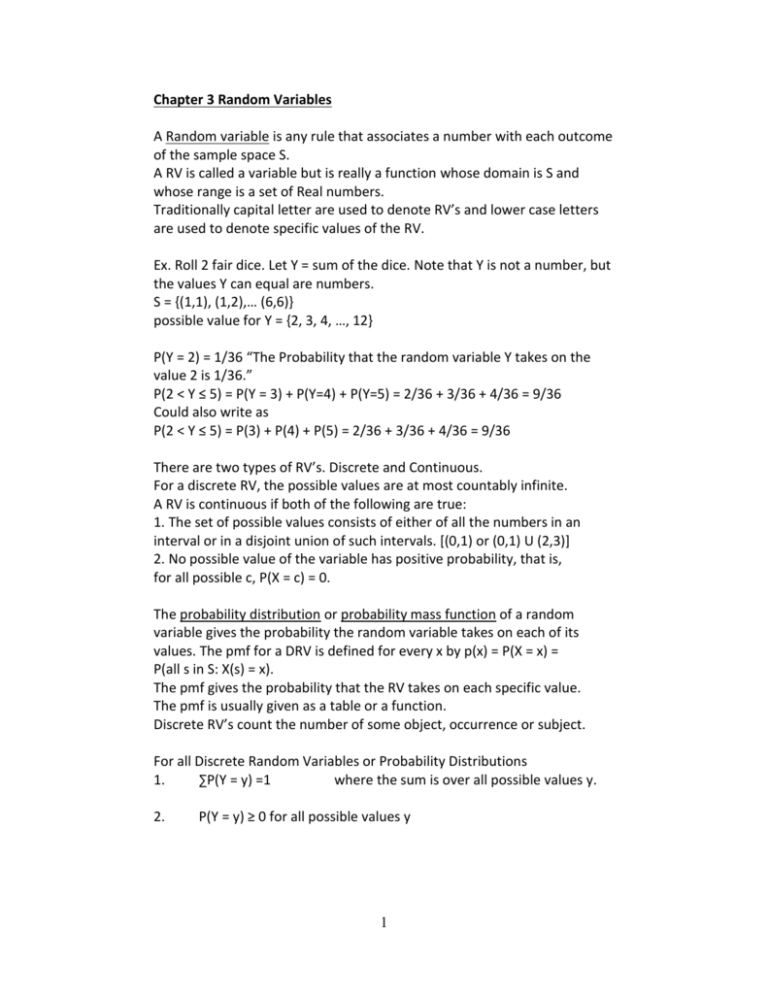
Chapter 3 Random Variables
A Random variable is any rule that associates a number with each outcome
of the sample space S.
A RV is called a variable but is really a function whose domain is S and
whose range is a set of Real numbers.
Traditionally capital letter are used to denote RV’s and lower case letters
are used to denote specific values of the RV.
Ex. Roll 2 fair dice. Let Y = sum of the dice. Note that Y is not a number, but
the values Y can equal are numbers.
S = {(1,1), (1,2),… (6,6)}
possible value for Y = {2, 3, 4, …, 12}
P(Y = 2) = 1/36 “The Probability that the random variable Y takes on the
value 2 is 1/36.”
P(2 < Y ≤ 5) = P(Y = 3) + P(Y=4) + P(Y=5) = 2/36 + 3/36 + 4/36 = 9/36
Could also write as
P(2 < Y ≤ 5) = P(3) + P(4) + P(5) = 2/36 + 3/36 + 4/36 = 9/36
There are two types of RV’s. Discrete and Continuous.
For a discrete RV, the possible values are at most countably infinite.
A RV is continuous if both of the following are true:
1. The set of possible values consists of either of all the numbers in an
interval or in a disjoint union of such intervals. [(0,1) or (0,1) U (2,3)]
2. No possible value of the variable has positive probability, that is,
for all possible c, P(X = c) = 0.
The probability distribution or probability mass function of a random
variable gives the probability the random variable takes on each of its
values. The pmf for a DRV is defined for every x by p(x) = P(X = x) =
P(all s in S: X(s) = x).
The pmf gives the probability that the RV takes on each specific value.
The pmf is usually given as a table or a function.
Discrete RV’s count the number of some object, occurrence or subject.
For all Discrete Random Variables or Probability Distributions
1.
∑P(Y = y) =1
where the sum is over all possible values y.
2.
P(Y = y) ≥ 0 for all possible values y
1
Ex. A package of 5 pens. Let Y be the RV that counts the number of pens
that are defective in the sample.
The probability distribution is given as follows:
Y
0
1
2
3
4
5
P(y) .75
.10
.06
.04
.03
.02
P(Y=0) = .75
0 pens of 5 was defective
P(Y=1) = .10
P(Y=2) = .06
P(Y=3) = .04
P(Y=4) = .03
P(Y=5) = .02
Note that all probabilities are between 0 and 1 and the sum of the
probabilities = 1.
What is the probability that at most 2 pens are defective?
P(Y ≤ 2) = P(Y=0) + P(Y=1) + P(Y=2) = .75 + .10 + .06 = .91
What is the probability that at least 1 pen is defective?
P( Y ≥ 1) = 1 – P(Y = 0) = 1 - .75 = .25
Ex. Let X be a DRV such that p(x) = .1x for x = 1, 2, 3, 4
the pmf as a table is:
X
1
2
3
4
p(x) .1
.2
.3
.4
Note that all p(x) > 0 and ∑p(x) = 1
Probability Histogram
0.45
0.4
0.35
0.3
0.25
p(x)
0.2
0.15
0.1
0.05
0
1
2
3
4
x
The cumulative distribution function (cdf) labeled F(x) for a DRV X with pmf
p(x) is defined for every x by:
F(x) = P(X ≤ x) = ∑p(y) (summation over all y ≤ x)
F(x) is the probability that X is less than or equal to x.
for any numbers a and b with a < b:
P(a ≤ X ≤ b) = F(b) – F(a –1)
2
Ex.
Y
P(y)
0
.75
1
.10
2
.06
3
.04
4
.03
5
.02
F(0) = .75 = P(Y ≤ 0)
F(1) = .85 = P(Y ≤ 1) = p(0) + p(1)
F(1.5) = .85 = P(Y ≤ 1.5)
p(1.5) = 0 = P(Y = 1.5)
P(2 ≤ Y ≤ 4) = F(4) – F(1) = .98 - .85 = .13 = p(2) + p(3) + p(4)
y
F(y) = P(Y ≤ y)
y<0
0
0≤y<1
.75
1≤y<2
.85
2≤y<3
.91
3≤y<4
.95
4≤y<5
.98
y≥5
1.0
There are a few special DRV we will mention by name shortly.
In Class: 11, 15, 24, 16
#11. X
4
6
p(x) .45
.40
8
.15
0.5
0.45
0.4
0.35
0.3
0.25
p(x)
0.2
0.15
0.1
0.05
0
4
6
8
x
c. P(X ≥ 6 ) = .55
P(X > 6) = .15
3
Expected Values
Expected value = mean (weighted by probabilities)
E(X) = μ = μx = ∑x P(X = x) = ∑x p(x)
E(X) is the mean of the conceptual population, long run average.
Pen example:
E(Y) = 0*.75 + 1*.10 + 2*.06 + 3*.04 + 4*.03 + 5*.02
E(Y) = .56
Does this mean that there is 0.56 defective pens in each package of 5?
No.
It means on average there is 0.56 defective pens in each package of 5.
So if you had 100 packages of 5 pens, there would be about 56 defective
pens.
Geometric RV: counts the number of “trials” until the first “success”.
trials mean the number of times the experiment is run.
success is not necessarily a good thing, just what you are counting.
If X has a geometric distribution, then the pmf is
p(x) = p(1 – p)x – 1
for x = 1, 2, 3, …
p(x) = 0
otherwise
p is the probability of a success at each trial.
So if p = .75 then the P(X = 2) = p(2) = .75 (.25) = .1875
Prove that E(X) = 1/p for X a Geometric RV with parameter p.
pf.
d
x
E ( X ) x 1 xp(1 p) x 1 p 1 p
x 1 dp
d
x
1 p
E ( X ) p
dp x 1
we know that
1 p x 1 p 1 p
1 (1 p )
p
x 1
so
d 1 p
p 1 p 1
p
E ( X ) p
p2
dp p
p
Properties of Expected Values:
Let X and Y be Discrete RV’s
1.
2.
If c is a constant then E(c) = c
If c is a constant then E(cX) = cE(X)
4
3.
E(X + Y) = E(X) + E(Y) = μx + μy
4.
In general, E(XY) ≠ E(X)E(Y), if X and Y are independent then
E(XY) = E(X)E(Y)
5.
Ex.
E(h(X)) = ∑ h(x) p(x)
E(X2) = ∑ x2 p(x)
6.
Variance(X) = V(X) = σ2 = E[(X – μ)2]
where μ = E(X)
Standard Deviation(X) = σ = √( σ2)
summed over all possible x.
Exercise:
Show that σ2 = E(X2) – μ2.
σ2 = E[(X – μ)2] = E[X2 –2μX + μ2 ] = E(X2 –2 μ2 + μ2)
σ2 = E(X2) – μ2
For pen example:
Recall E(Y) = .56
Y
P(Y)
0
0.75
1
0.1
2
0.06
3
0.04
4
0.03
5
0.02
Y–μ
(Y – μ )^2
*p(y)
-0.56
0.3136
0.2352
0.44
0.1936
0.01936
1.44
2.0736
0.124416
2.44
5.9536
0.238144
3.44
11.8336
0.355008
4.44
19.7136
0.394272
Variance
Stdev
1.366
1.169
Y
P(Y)
0
0.75
1
0.1
2
0.06
3
0.04
4
0.03
5
0.02
Y^2
E(Y^2)
0
1.68
0.1
0.24
0.36
0.48
0.5
Variance
Stdev
1.366
1.169
Let X be a RV with mean μ and variance σ2, and let a and b be real
numbers, then
V(aX + b) = σ2 (aX + b) = a2 σ2, and σ(aX + b) = |a|σ
#29
x
p(x)
0
.08
1
.15
2
.45
3
.27
4
.05
5
E(X) = 0*.08 + 1*.15 + 2*.45 + 3*.27 + 4*.05
E(X) = 0 + .15 + .90 + .81 + .20 = 2.06
V(X) = .08*2.062 + .15*1.062 + .45*.062 + .27*.942 + .05*1.942
V(X) = .9364
σ = .9677
E(X2) = .08*0 +.15*1 +.45*4 + .27*9 + .05*16 = 5.18
V(X) = 5.18 – 2.062 = .9364
Chebyshev’s Inequality
Let X be a RV with mean μ, standard deviation σ, and k > 1, then
P(|X - μ)| ≥ kσ) ≤ 1/k2.
#44
The probability that any value x is at least k standard deviations from the
mean is at most 1/k2.
P(|X - μ)| ≥ 2σ) ≤ ¼ = .25
P(|X - μ)| ≥ 3σ) ≤ 1/9 = .111
P(|X - μ)| ≥ 4σ) ≤ 1/16 = .0625
P(|X - μ)| ≥ 5σ) ≤ 1/25 = .04
P(|X - μ)| ≥ 10σ) ≤ 1/100 = .01
What does P(|X – μ| ≥ 3σ) mean?
P(|X – μ| ≥ 3σ) = P(X - μ ≤ -3σ) + P(X – μ ≥ 3σ)
P(X ≤ μ – 3σ) + P(X ≥ μ + 3σ)
For exercise 13, μ = 2.64 and V(X) = 2.3074
σ = 1.5440
P(|X – μ| ≥ 3σ) = P(X ≤ 2.64 – 3*1.544) + P(X ≥ μ + 3*1.544)
= P(X ≤ 2.64 – 4.632) + P(X ≥ 2.64 + 4.632) =
P(X ≤ -1.992) + P(X ≥ 7.272) = 0 which ≤ 1/9
The bounds are conservative.
c.
X
p(x)
x*p(x)
x*x*p(x)
-1
1/18
0
8/9
1
1/18
- 1/18
1/18
0/18
0/18
1/18
1/18
E(X) = 0
E(XX) = 1/9
V(X) = 1/9
σ = 1/3
P(|X – μ| ≥ 3σ) = P(X ≤ -1) + P(X ≥ 1) = 1/9
by Chebyshev’s Inequality
P(|X – μ| ≥ 3σ) ≤ 1/9, so the inequality is exact.
6
d.
X
p(x)
x*p(x)
x*x*p(x)
-1
1/50
0
24/25
1
1/50
- 1/50
1/50
0/50
0/50
1/50
1/50
The Binomial Probability Distribution.
Ex.
Test of 3 Multiple Choice Questions. The probability of getting any
one question right is ¼ = .25 Assume that the questions are independent.
Let Y = # of questions right
S = {RRR, RRW, RWR, WRR, WWR, WRW, RWW, WWW}
Note: P(Y=3)=P(RRR) ≠1/8
The outcomes are not equally-likely!
A tree diagram may help.
P(Y=0) =¾*¾*¾ = 27/64=.42
P(Y=1)=P(RWW+WRW+WWR)
P(Y=1) =3 * (¾*¾*¼) = 27/64 =.42
P(Y=2)=P(WRR+RWR+RRW)
P(Y=2) =3 * (¾*¼*¼) = 9/64 =.14
P(Y=0)=P(RRR)=¼*¼*¼ =1/64 = .02
Note: 27/64+27/64+9/64+1/64=1
A Binomial Random Variable counts the number of “successes” in n trials.
Ex. The number of correct answers in 3 questions.
Five Characteristics of a Bin R.V.
1.
Fixed # n of identical trials. Ex. 3 True-False questions or Selecting
10 people from a large population.
2. The outcome of each trial can be classified as a Success or Failure.
Success is not necessarily a good thing.
3. The probability of a Success at each trial = p, is the same for all trials.
This also means that the probability of a Failure is the same also = 1-p = q.
4. The trials of the experiment are independent. Outcomes of previous
trials to not affect future trials.
5. The random variable counts the number of Successes in the n trials.
Clues that the RV is Binomial.
1. Random sample of size n
7
2. Sample comes from a large population, or sampling with replacement.
(this will make the trials independent)
3. Each trial can be classified as a Success or Failure.
Binomial Formula
P(X = x) =b(x; n, p)= n C x p x q n – x
For x = 0, 1, 2, … , n
For Multiple Choice test example. Y is Bin(n=3, p = 1/4 )
Sampling with replacement, if you answer T to question 1 you can answer
T again, T is replaced.
k = 0 means 0 questions correct.
P(Y=0) = 3 C 0 (¼) 0 (¾) 3
P(Y=0) = 1 (1) (27/64) = 27/64
k = 1 means 1 question correct.
P(Y=1) = 3 C 1 (¼) 1 (¾) 2
P(Y=1) = 3 (9/16) (1/4) = 9/64
On the TI83/84
[2nd] [DIST] (VARS key)
0: binompdf(n, p, x)
binompdf (n, p, x) gives P(Y = x)
b(x; n, p)
if Y is Bin(n=3, p = ¼ )
P(Y = 2) = binompdf(3, ¼ , 2) = 9/64 = 0.1406
On the TI83/84
[2nd] [DIST] (VARS key)
binomcdf(n, p, x)
binomcdf(n, p, x) gives P(Y ≤ x)
B(x; n, p)
if Y is Bin(n=10, p = .6)
P(Y ≤ 8) = binomcdf(10, .6, 8) = 0.9536
B(8; 10, .6)
What if you were asked for P(Y > 8)?
P(Y > 8) = 1 – P(Y ≤ 8) = 1 - .9536 =.0464
Use pdf for probability that Y exactly = a number and
Use cdf for probability that Y <, > , ≤ , ≥ numbers.
8
Ex.
In the NBA Dolph Schayes makes 90% of his free throws. In a particular
game he shoots 10 free throws. Let X count the number free throws made.
What must you assume for X to have a binomial distribution. Specify n and
p. Find the probability that he made all 10 free throws. Find the probability
that he made 9 free throws.
Clues that it is binomial: sampling with replacement, each trial is a success
or failure. A success = made the free throw.
a. we need to assume that the free throws are independent.
b. n = 10 and p = .9
c. P(X = 10) = use pdf = P(X = 10) = .3487
P(X = 9) use pdf = P(X = 9) = .3874
Extra Questions:
What is the probability that Dolph makes:
d. at most 9 free throws
P(X ≤ 9) = use cdf = P(X ≤ 9) = .6513
Or P(X ≤ 9) = 1 – P(X > 9) = 1 – P(X =10) = 1 - .3487
e. at least 8 free throws?
P(X ≥ 8) = 1 – P(X < 8) = 1 - P(X ≤ 7) = 1 - .0702 = .9298
f. 0 free throws.
P(X = 0) = 1 E-10 = 0.0000000001 ≈ 0
g. at least 1 free throw.
P(X ≥ 1) = 1 – P(X = 0) ≈ 1 – 0 ≈ 1
The mean or expected value of a Binomial RV is μ = np.
The standard deviation of a Binomial RV is σ = √(npq)
Recall q = 1- p
Ex2. It is known that 10% of the US population is left-handed. A random
sample of 15 people is taken.
1. What is the probability exactly 0 people are left-handed?
2. What is the probability exactly 1 person is left-handed?
3. What is the probability exactly 2 people are left-handed?
4. What is the probability less than 3 people are left-handed?
5. What is the probability of at least one left-handed person?
9
6. What are the mean and the standard deviation of left handed people in
the sample?
Answers:
Let X count the number of left-handed people in the sample. Since we
have a large population and each trial can be classified as a success or
failure, X is a binomial random variable. Its parameters are n = 15 and p =
0.10. Then the answers to the questions are:
1.
P(X = 0) = .2059
2.
P(X = 1) = .3432
3.
P(X = 2) = .2669
4.
P(X < 3) = P(X≤ 2)=.8159 (used cdf)
P(X< 3) = .2059 + .3432 + .2669
P(X <3) = .816 (Round off error)
5.
P(X ≥ 1) = 1 – P(X < 1) = 1 – P(X = 0) = 1 - .2059 = .7941
6.
μ= n*p = 15 * .1 = 1.5
σ = √(npq) = √(15 * .1 * .9) = √1.35 = 1.162
In Class. 48, 55, 57, 62
48. Circuit Boards
X = number of defective circuit boards in the sample.
n = 25, p = .05.
X ~ binomial because we are sampling from a large population.
a. P(X ≤ 2) = .8729 = probability that there are at most 2 defectives.
b. P(X ≥ 5) = 1 – P(X ≤ 4) = 1 - .9928 = .0072 = Probability that there are at
least 5 defectives.
c. P(1 ≤ X ≤ 4) = .7154 = Probability that there are between 1 and 4
defectives, inclusive.
d. P(X = 0) = .2774
e. μ = 25 * .05 = 1.25
σ = √(25 * .05 * .95) = 1.090
Prove that b(x; n, p ) = b(n - x; n, 1 – p)
Let q = 1 - p
b(x; n, p ) = nCx px q n-x
b(n-x; n, q ) = nC(n-x) qn-x (1- q) n-(n-x)
but 1 – q = p and n – (n – x) = x and we have previously shown that
nCx = nC(n-x) so
b(n-x; n, q ) = nCx qn-x p x = b(x; n, p )
Ex. Suppose we have 20 computers. Unknown to you, 20% or 4 computers
are defective and will explode when you turn them on. You are to test a
random sample of 3 computers. What is the probability that exactly 1 of
10
the computers explodes? What is the probability that exactly 2 of the
computers explodes?
What is the probability that exactly 3 of the computers explodes? What is
the probability that exactly 0 of the computers explodes?
Your first thought may be to use the binomial distribution, with n = 3, p =
4/20 = 1/5 = .2. But this is not correct because the population (20) is not
large. Sure the probability of selecting a defective computer on the first
selection is 4/20, but what about the second selection? If you selected the
a defective computer on the first try, then the probability of selecting a
defective computer on the second selection is 3/19 = .158, but if you did
not select a defective computer on the first try, then the probability of
selecting a defective computer on the second selection is 4/19 = .210. This
violates the assumption of independence and a constant p of the binomial
distribution. So how to do this problem:
Use the Hyper-Geometric Distribution.
Y is the random variable which counts the number of successes in the
sample of size n from a population of size N and M is the total number of
successes in the population. It is much like the Binomial, but used when
n > .05 N. Each outcome can be characterized as a Success or Failure and
there is a sample of size n.
The pdf for the Hyper-Geometric RV is:
MCx * ( N M )C (n x) C ( x, M ) * C (( n x), ( N M ))
NCn
C (n, N )
max[0, n – (N-M)] ≤ k ≤ min [M, n]
P(Y x)
In the computer example above:
N = 20, n = 3, M = 4 where Y counts the number of defective computers.
P(Y = 1) = 4 C 1 * 16 C 2 / 20 C 3 = 480 / 1140 = .421
h(y; n, M, N) = h(1; 3, 4, 20)
k
0
1
2
3
P(Y = k)
0.491
0.421
0.084
0.004
The above probabilities were found using the HYPGEOMDIST function in
Excel. Sad to say that your calculators do not have a Hyper-Geometric
function.
Note that as N increases the Hyper-Geometric distribution approaches the
Binomial distribution. In fact most problems that we use the Binomial for,
are theoretically Hyper-Geometric. However, we rarely know the
11
population size, N, and the approximation is very good. How good? We
shall see lab.
Note also that we did problems like this already in chapter 3 when we did
combination problems.
Ex. There are 15 students in a class. There are 8 women and 7 men. 4 are
randomly selected to be on a committee. Let Y be the number of women
on the committee. Find the probability distribution of Y.
Y is Hyper-Geometric with N = 15, n = 4, M = 8. Possible values for Y = 0, 1,
2, 3, 4
k
0
1
2
3
4
P(Y = k)
0.026
0.205
0.431
0.287
0.051
Also note that if Y is Hyper-Geometric with N, n and M then
Mn
E (Y )
N
( N n) nM M
Var (Y )
*
* 1
( N 1) N
N
so for the previous example:
E(Y) = 8*4/15 = 2.133
V(Y) = 8(7)(4)(11)/225*14 = .783
σ = .884
In Class: 68, 71
64. 68. Cameras. X = number of 3 mega-pixel cameras in sample.
X ~ HG(n=5, M=6, N=15)
P(X =2) = 1260/3003 = .4196
P(X ≤2) = (126 + 756 + 1260)/3003 = 2142/3003 = .7133
P(X ≥ 2) = 1 – (P(0) + P(1)) = 2373/3003 = .7902
71
The Negative Binomial Distribution
1. Sequence of independent trials. (With replacement or large population)
12
2. Each trial results in a Success (S) or Failure (F).
3. The probability for a success is constant from trial to trail.
P(S on any trial) = p
4. The experiment continues until r successes are observed, r is a preset
positive integer.
X counts the number of failures that precede the rth success.
X~NB(r, p)
x
nb( x; r , p) x r 1C r 1 p r 1 p
x=0, 1, 2, …
E( X )
r (1 p)
p
V (X )
r (1 p)
p2
Notes: for a Negative Binomial RV, there is no fixed sample size.
Some other books count the total number trial not the failures.
75. Sex of children
p = .5, 1 – p = .5
X = number of male children until 2 females, so r = 2
P(X = x) = (x + 1)C 1 (.52)(.5x) x = 0, 1, …
P(X = x) = (x + 1) .52+x x = 0, 1, …
P(X = 2) = 3 C 1 .54 = 3/16 = .1875
P(at most 4 children) = P(X ≤ 2) = P(0) + P(1) + P(2)
= .25 + .25 + .1875 = .6875
E(Males) = 2 * .5 / .5 = 2
E(number of children) = 2 + 2 = 4
The Geometric Distribution is a special case of the Negative Binomial
when r =1, and usually counts the number of trials, not failures.
Ex. A door-to-door encyclopedia salesman is required to document 5 inhome visits each day. Suppose that he has a 30% chance of being invited
into a home and that each home is independent. What is the probability
that he requires fewer than 8 houses to achieve the 5 required?
nb(x; p = .3, r = 5)
13
P(X < 3) = P(X ≤ 2) = P(X = 0) + P(X = 1) + P(X = 2)
P(X = 0)= 4 C 4 * .3^5 * .7^0 = .0024
P(X = 1) = 5 C 4 * .3^5 * .7^1 = .0085
P(X = 2) = 6C4 * .3^5 * .7^2 = .0178
P(X < 3) = .0288
The Poisson Distribution
Characteristics:
1.
The experiment consists of counting the number of times a certain
event occurs during a specific time or in an area.
2.
The Probability that the event occurs in a given time or area is the
same for all units.
3.
The number of events that occur in one unit is independent of the
other units of time or area.
4.
The mean or expected number of events in each unit is denoted by
the Greek letter lambda = λ.
If Y has a Poisson Distribution with mean λ then the pdf for Y is:
x e
P( X x)
=p(x; λ) for k = 0, 1, 2, …
x!
E(Y) = λ and Var(Y) = λ
Ex.
The average number of occurrences of a certain disease in a certain
population is 2 per 1000 people. In a random sample of 1000 people from
this population, what is the probability that exactly 1 person in the sample
has the disease? What is the probability that at least 1 person in the
sample has the disease?
Y = counts the number of people in the sample with the disease.
Y has a Poisson distribution with λ = 2.
P(Y = 1) = 21 * e -2 / 1! = .270
P(Y ≥ 1) = 1 – P(Y = 0) = 1 - .135 = .865
On the TI83/84
[2nd] [DIST] (VARS key)
C: poissonpdf(λ, k)
poissonpdf(λ, k) gives P(Y = k)
for the last example:
14
poissonpdf(2, 1) = .270
poissonpdf(2, 0) = .135
On the TI83/84
[2nd] [DIST] (VARS key)
poissoncdf(λ, k)
poissoncdf(λ, k) gives P(Y ≤ k)
In Class: 75, 83
79.
X ~ Poisson(λ = 5)
P(X ≤ 8) = .9319
P(X = 8) = .932 - .867 = .065
P(9 ≤ X) = 1 - .932 = .068
P(5 ≤ X ≤ 8) = .932 - .440 = .492
P(5 < X < 8) = P(X ≤ 7) – P(X ≤ 5) = .867 - .616 = .251
88.
15
